
|
You entered: arcs
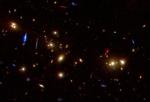 The Lynx Arc
The Lynx Arc
4.11.2003
While chasing the spectrum of a mysterious arc in a cluster of galaxies within the obscure northerly constellation Lynx, astronomers have stumbled upon the most massive and distant star-forming region ever discovered. The notably...
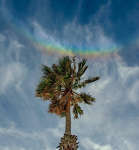 When Rainbows Smile
When Rainbows Smile
10.03.2022
Want to see a rainbow smile? Look near the zenith (straight up) when the sun is low in the sky and you might. This example of an ice halo known as a circumzenithal arc was captured above a palm tree top from Ragusa, Sicily on February 24.
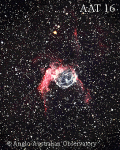 A Wolf Rayet Star Bubble
A Wolf Rayet Star Bubble
28.09.1997
What's a Wolf-Rayet star, and how did it create that spherical bubble and sweeping arc? A Wolf-Rayet star is a star that originated with a mass over 40 times that of our Sun.
 A Wolf-Rayet Star Bubble
A Wolf-Rayet Star Bubble
26.08.1996
What's a Wolf-Rayet star, and how did it create that spherical bubble and sweeping arc? A Wolf-Rayet star is a star that originated with a mass over 40 times that of our Sun.
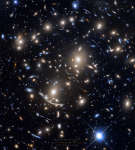 Abell 370: Galaxy Cluster Gravitational Lens
Abell 370: Galaxy Cluster Gravitational Lens
18.03.2019
What are those strange arcs? While imaging the cluster of galaxies Abell 370, astronomers noticed an unusual arc. The arc wasn't understood right away -- not until better images showed that...
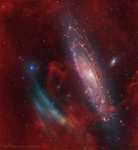 APOD: 2023 January 17 Б Unexpected Clouds Toward the Andromeda Galaxy
APOD: 2023 January 17 Б Unexpected Clouds Toward the Andromeda Galaxy
16.01.2023
Why are there oxygen-emitting arcs near the direction of the Andromeda galaxy? No one is sure. The gas arcs, shown in blue, were discovered and first confirmed by amateur astronomers just last year.
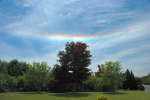 A Fire Rainbow Over New Jersey
A Fire Rainbow Over New Jersey
10.06.2008
What is that inverted rainbow in the sky? Sometimes known as a fire rainbow for its flame-like appearance, a circumhorizon arc is created by ice, not fire. For a circumhorizon arc to be visible, the Sun must be at least 58 degrees high in a sky where cirrus clouds are present.
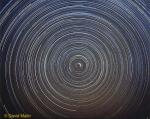 Star Trails in Northern Skies
Star Trails in Northern Skies
30.11.1996
As the Earth spins on its axis, the sky seems to rotate around us. This motion produces the beautiful concentric arcs traced out by the stars in this time exposure of the night sky.
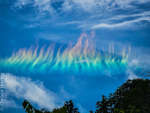 A Fire Rainbow over West Virginia
A Fire Rainbow over West Virginia
29.08.2021
What's happening to this cloud? Ice crystals in a distant cirrus cloud are acting like little floating prisms. Known informally as a fire rainbow for its flame-like appearance, a circumhorizon arc appears parallel to the horizon.
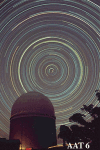 Star Trails in Southern Skies
Star Trails in Southern Skies
25.09.1995
As the Earth spins on its axis, the sky seems to rotate around us. This motion produces the beautiful concentric arcs traced out by the stars in this time exposure of the night sky. In the foreground of the picture is the dome of the Anglo-Australian Telescope in central New South Wales Australia.
|
January February March April May June July |
|||||||||||||||||||||||||||||||||||||||||||||||||